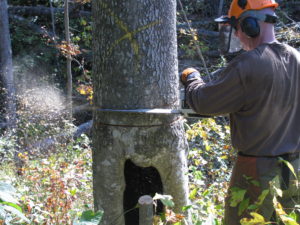 Timber stand improvement, or TSI can be generally summed up as the improvement of the health and quality of a forest by focusing available sunlight and soil nutrients on the most valuable tree species. This is accomplished through practices such as pre-harvest grapevine removal, post-harvest opening completion and crop tree release.
Timber stand improvement, or TSI can be generally summed up as the improvement of the health and quality of a forest by focusing available sunlight and soil nutrients on the most valuable tree species. This is accomplished through practices such as pre-harvest grapevine removal, post-harvest opening completion and crop tree release.
While the native grape vines that we have in Indiana are great for wildlife, they can cause many issues for trees. The vines can deform tree crown development and compete for sunlight. This can eventually either completely kill the tree or cause severe defects. A critical time to perform grape vine removal is prior to a harvest activity, to minimize damage to adjacent residual trees during the harvest operation.
Post-harvest opening TSI involves the removal of low quality or damaged trees that might remain in a forest opening after a harvest. This allows for more light to reach the forest floor and for the germination of high-quality hardwood tree species such as Black Walnut and Oaks. Such species need plentiful sunlight to become established.
Crop tree release involves deadening poor quality trees adjacent to valuable crop trees to provide more sunlight to the crown. This results in increased vigor and diameter growth of the crop tree.
